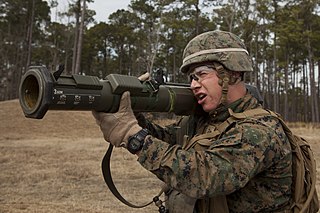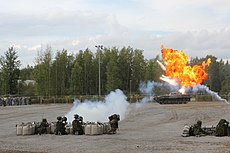
Saab AB is a Swedish aerospace and defence company, founded in 1937. Saab produced automobiles from 1947 until 1990 when the automobile division was spun off as Saab Automobile, a joint venture with General Motors. The joint venture ended in 2000 when GM took complete ownership. Between 1968 and 1995 the company was in a merger with commercial vehicle manufacturer Scania-Vabis, known as Saab-Scania. The two were de-merged in 1995 by the new owners, Investor AB. Despite the demerger, both Saab and Scania share the right to use the griffin logo, which originates from the coat of arms of the Swedish region of Scania.

AB Bofors is an old Swedish arms manufacturer which today is part of the British arms concern BAE Systems. The name has been associated with the iron industry and artillery manufacturing for more than 350 years.

The Visby class is a warship in use by the Swedish Navy. It is the latest class of corvette adopted by the navy after the Göteborg and Stockholm-class corvettes. Its design emphasizes low visibility radar cross-section and infrared signature, and the class has received widespread international attention because of its capabilities as a stealth ship.

Meteor is an active radar guided beyond-visual-range air-to-air missile (BVRAAM) developed by MBDA. Meteor offers a multi-shot capability, and has the ability to engage highly maneuverable targets, such as jets, and small targets such as UAVs and cruise missiles in a heavy electronic countermeasures (ECM) environment with a range in excess of 100 kilometres (54 nmi). A solid-fueled ramjet motor allows the missile to cruise at a speed of over Mach 4 and provides the missile with thrust and mid-course acceleration to target intercept. A two-way datalink enables the launch aircraft to provide mid-course target updates or retargeting if required, including data from off-board third parties. The datalink is capable of transmitting missile information such as functional and kinematic status, information about multiple targets, and notification of target acquisition by the seeker.

Starstreak is a British short-range man-portable air-defence system (MANPADS) manufactured by Thales Air Defence, in Belfast, Northern Ireland. It is also known as Starstreak HVM. After launch, the missile accelerates to more than Mach 4, making it the fastest short-range surface-to-air missile in existence. It then launches three laser beam-riding submunitions, increasing the likelihood of a successful hit on the target. Starstreak has been in service with the British Army since 1997. In 2012 Thales relaunched the system as ForceSHIELD.

The FGM-148 Javelin, or Advanced Anti-Tank Weapon System-Medium (AAWS-M), is an American-made portable anti-tank missile system in service since 1996, and continuously upgraded. It replaced the M47 Dragon anti-tank missile in US service. Its fire-and-forget design uses automatic infrared guidance that allows the user to seek cover immediately after launch, in contrast to wire-guided systems, like the system used by the Dragon, which require a user to guide the weapon throughout the engagement. The Javelin's high explosive anti-tank (HEAT) warhead can defeat modern tanks by top attack, hitting them from above, where their armor is thinnest, and is also useful against fortifications in a direct attack flight.

The Carl-Gustaf recoilless rifle, designated in Swedish service as the Granatgevär m/48, is an 84-mm man-portable reusable anti-tank weapon originally produced by Carl Gustafs Stads Gevärsfaktori in Sweden. Developed in 1946, it was one of the many recoilless rifle designs of that era. While similar weapons have generally disappeared from service, the Carl-Gustaf is still in production and remains in widespread use today. The Carl-Gustaf is a lightweight, low-cost weapon that uses a wide range of ammunition, which makes it extremely flexible and suitable for a wide variety of roles.

FFV-Carl Gustaf was a Swedish armaments firm, bought up and merged on several occasions.

RBS 70 is a man-portable air-defense system (MANPADS) designed for anti-aircraft warfare in all climate zones and with little to no support from other forces. Originally designed and manufactured by the Swedish defence firm of Bofors Defence. It uses the RB 70 missile which is also in use in a number of other Swedish missile systems.

The RBS 15 is a long-range fire-and-forget surface-to-surface and air-to-surface anti-ship missile. The later version Mk. III has the ability to attack land targets as well. The missile was developed by the Swedish company Saab Bofors Dynamics.

The FGM-172 SRAW, also known as the Predator SRAW, was a lightweight, close range missile system produced by Lockheed Martin, developed by Lockheed Martin and Israel Military Industries. It was designed to complement the Javelin anti-tank missile. The Predator had a longer range and was more powerful than the AT4 that it was designed to replace, but had a shorter range than the Javelin.
Saab Bofors Dynamics, located in Karlskoga and Linköping, Sweden, is a subsidiary of the Saab Group that specializes in military materiel such as missile systems and anti-tank systems.

Stridsvagn 122 (IPA: [ˈstrɪ̂tːsvaŋn]; is a Swedish main battle tank based on the German Leopard 2 improved variant, just like the German Leopard 2A5, utilizing newer technology such as command-, control-, and fire-control systems, as well as reinforced armour and long-term combat capacity. Externally, the vehicle can be distinguished from the Leopard 2A5 by the French GALIX smoke dispensers, different storage bins, and the thicker crew hatches. The Strv 122B, has been equipped with modular AMAP composite armor from IBD Deisenroth to give "360° protection" against threats such as explosively formed penetrators, rocket propelled grenades and improvised explosive devices.

Slat armor, also known as bar armor, cage armor, and standoff armor, is a type of vehicle armor designed to protect against high-explosive anti-tank (HEAT) attacks, as used by rocket-propelled grenades (RPG).

A main battle tank (MBT), also known as a battle tank or universal tank, is a tank that fills the armor-protected direct fire and maneuver role of many modern armies. Cold War-era development of more powerful engines, better suspension systems and lighter-weight composite armor allowed the design of a tank that had the firepower of a super-heavy tank, the armor protection of a heavy tank, and the mobility of a light tank, in a package with the weight of a medium tank. Through the 1960s, the MBT replaced almost all other types of tanks, leaving only some specialist roles to be filled by lighter designs or other types of armored fighting vehicles.

The AT4 is a Swedish 84 mm (3.31 in) unguided, man-portable, single-shot, disposable, recoilless smoothbore anti-tank weapon built by Saab Bofors Dynamics. Saab has had considerable sales success with the AT4, making it one of the most common light anti-tank weapons in the world.

The Skif or Stugna-P is a Ukrainian anti-tank guided missile (ATGM) system developed by the Luch Design Bureau. Its guidance device (ПН-С) is developed and manufactured by Belarusian design bureau Peleng based in Minsk. Skif is the Ukrainian word for Scythian and Stuhna (Stugna) is the name of a local river.

Operation Orbital is the code-name for a British military operation to train and support the Armed Forces of Ukraine. It was launched in 2015 in response to the 2014 Russian annexation of Crimea and it was suspended in 2022 ahead of the Russian invasion of Ukraine. Prior to its suspension, the operation had successfully trained over 22,000 Ukrainian military personnel in a range of skills to help defend the territorial integrity of their country, including infantry, medical, logistics and counter-IED skills.
This article is about the weapons and equipment used in the Russo-Ukrainian war, covering the Russian annexation of Crimea, the war in Donbas and the 2022 Russian military operation which involves the Armed Forces of the Russian Federation, the Armed Forces of Ukraine, and a variety of irregular forces. Nearly all combatants were armed with Soviet origin weapons and equipment such as the AK-74 assault rifle, T-72 main battle tank and Su-25 close air support aircraft. However, many Russian combatants are equipped with modernised Russian equipment, while Ukraine has received significant support both from its domestic arms industry, as well as aid from NATO countries such as the United States and United Kingdom, providing support in the form of equipment such as the British NLAW and American Javelin portable anti tank systems.























